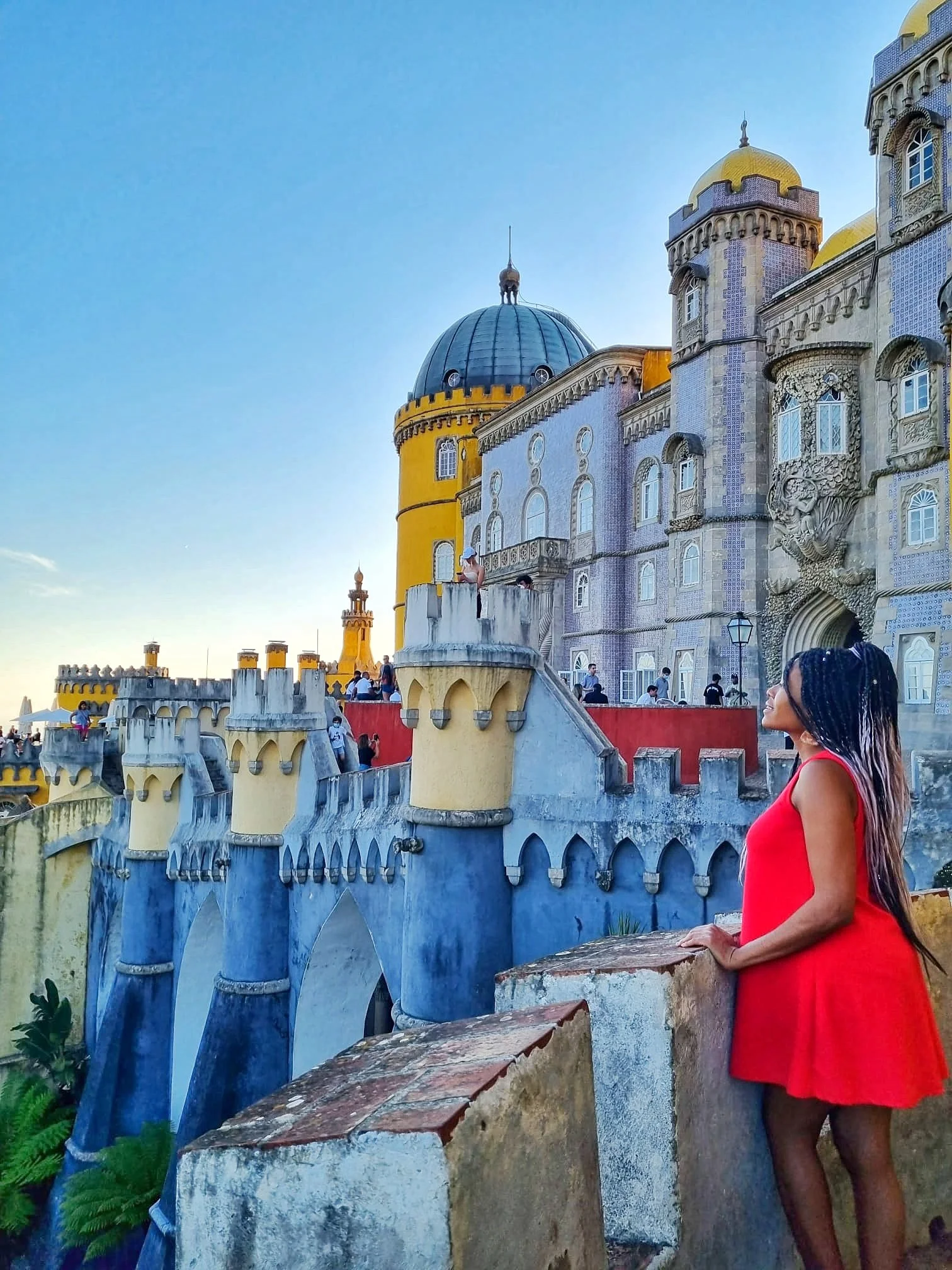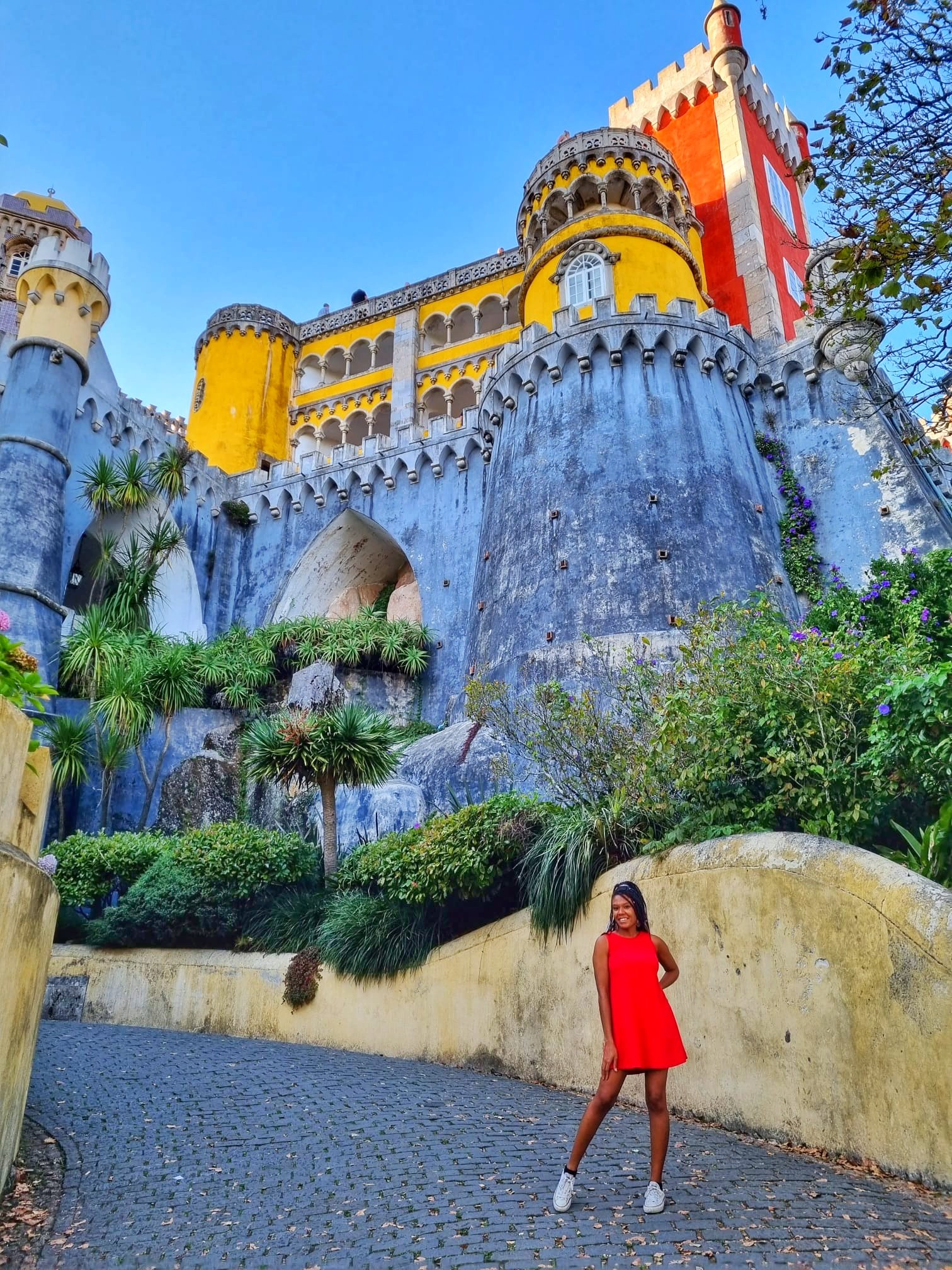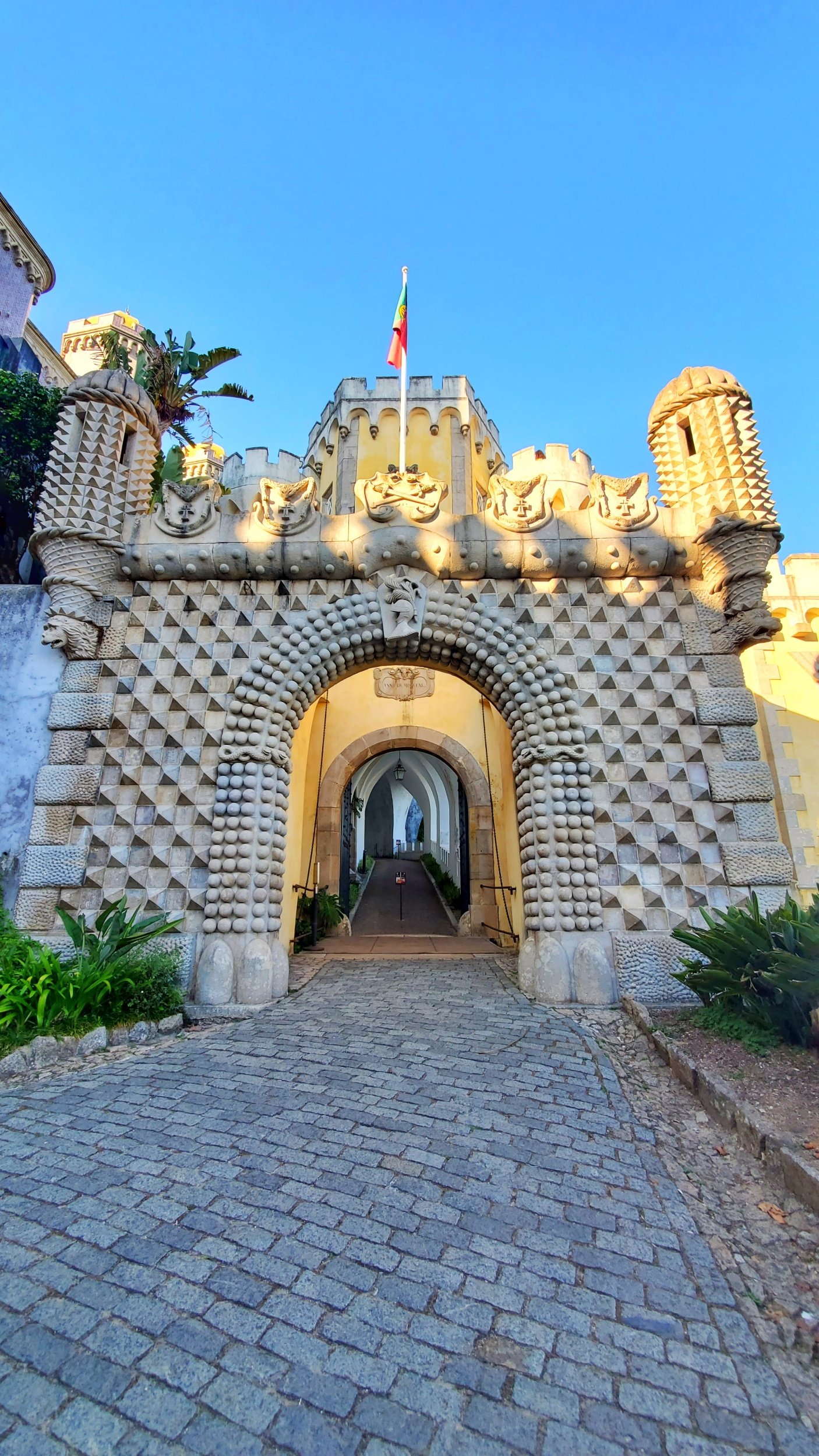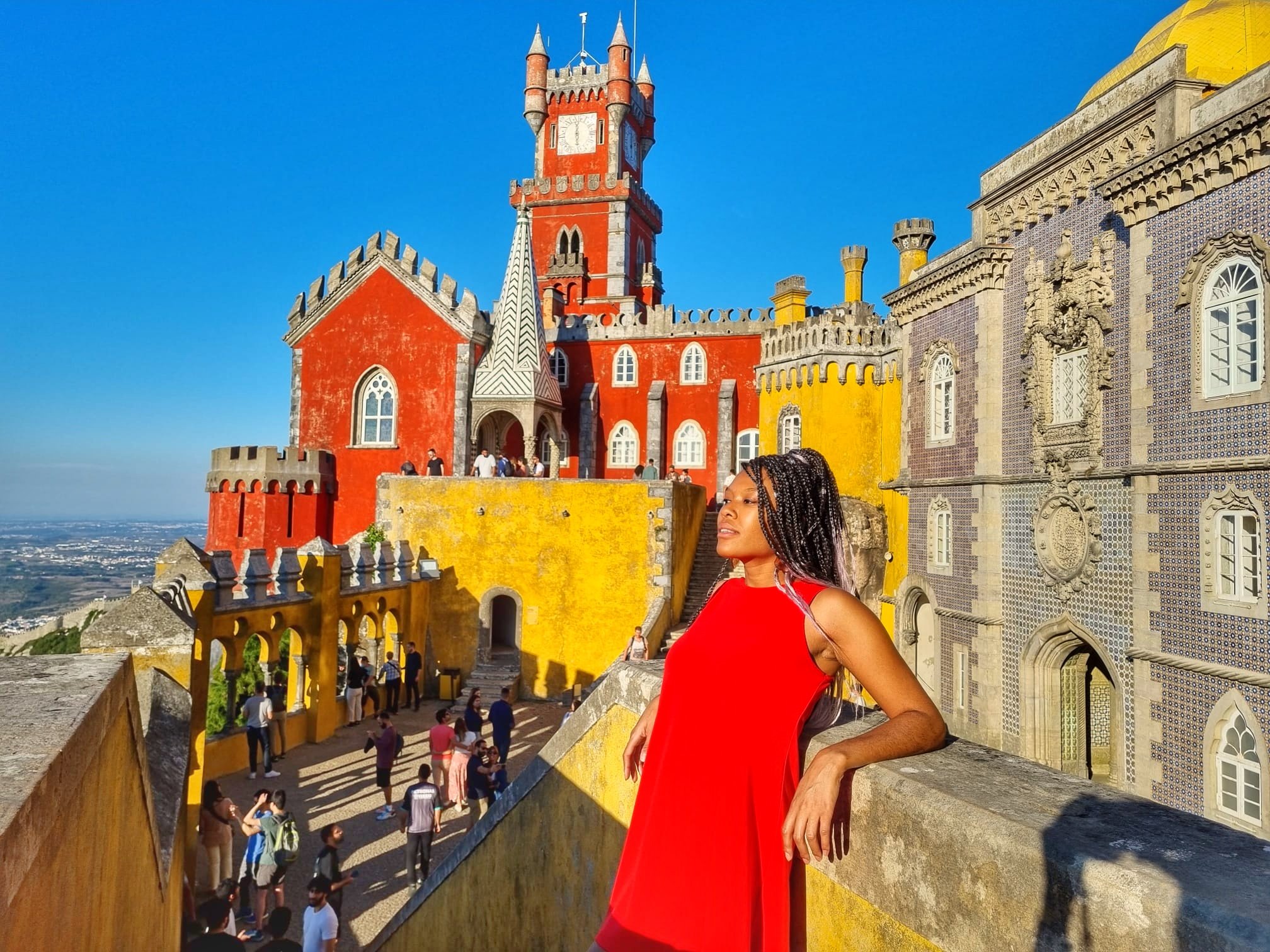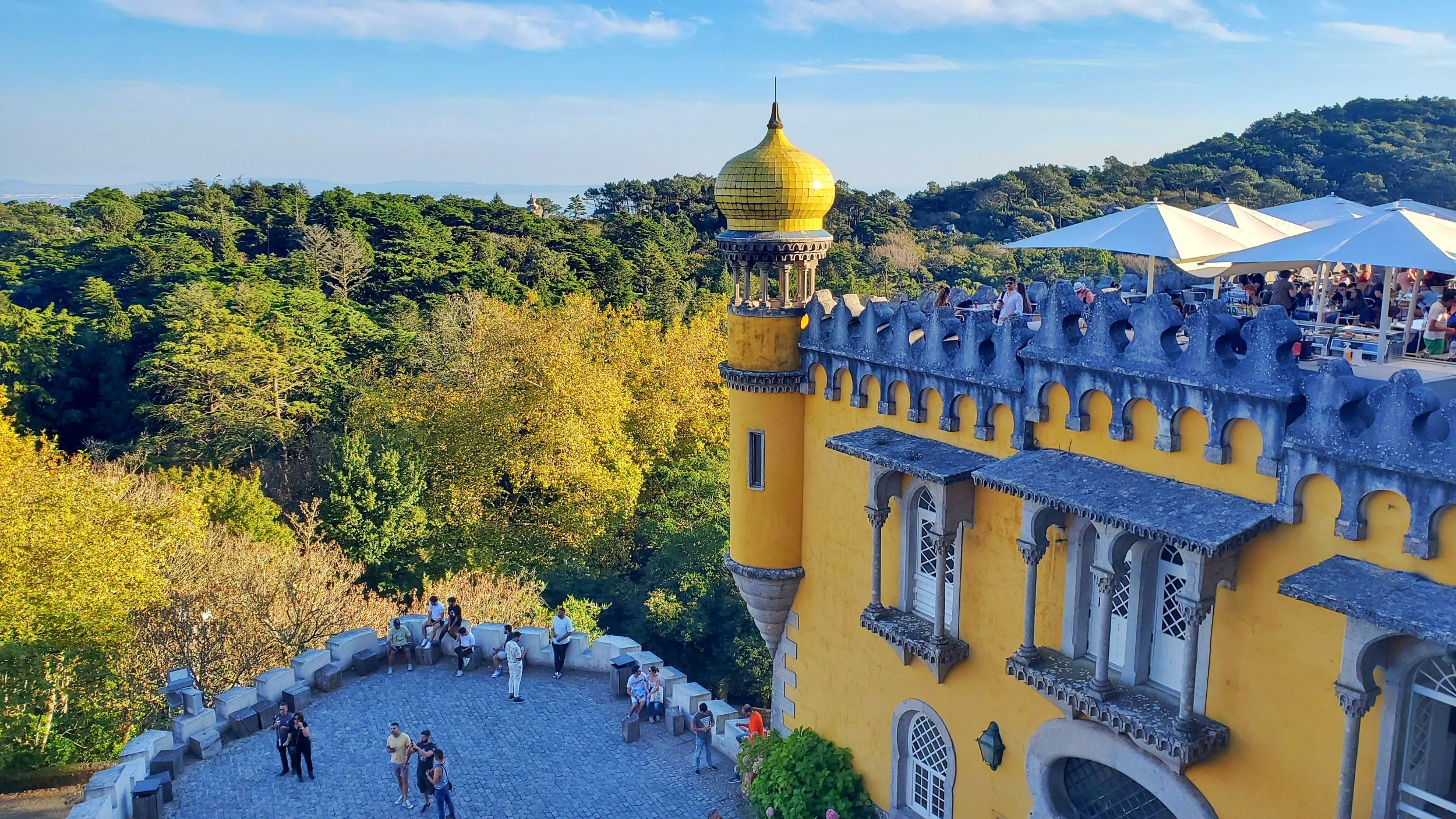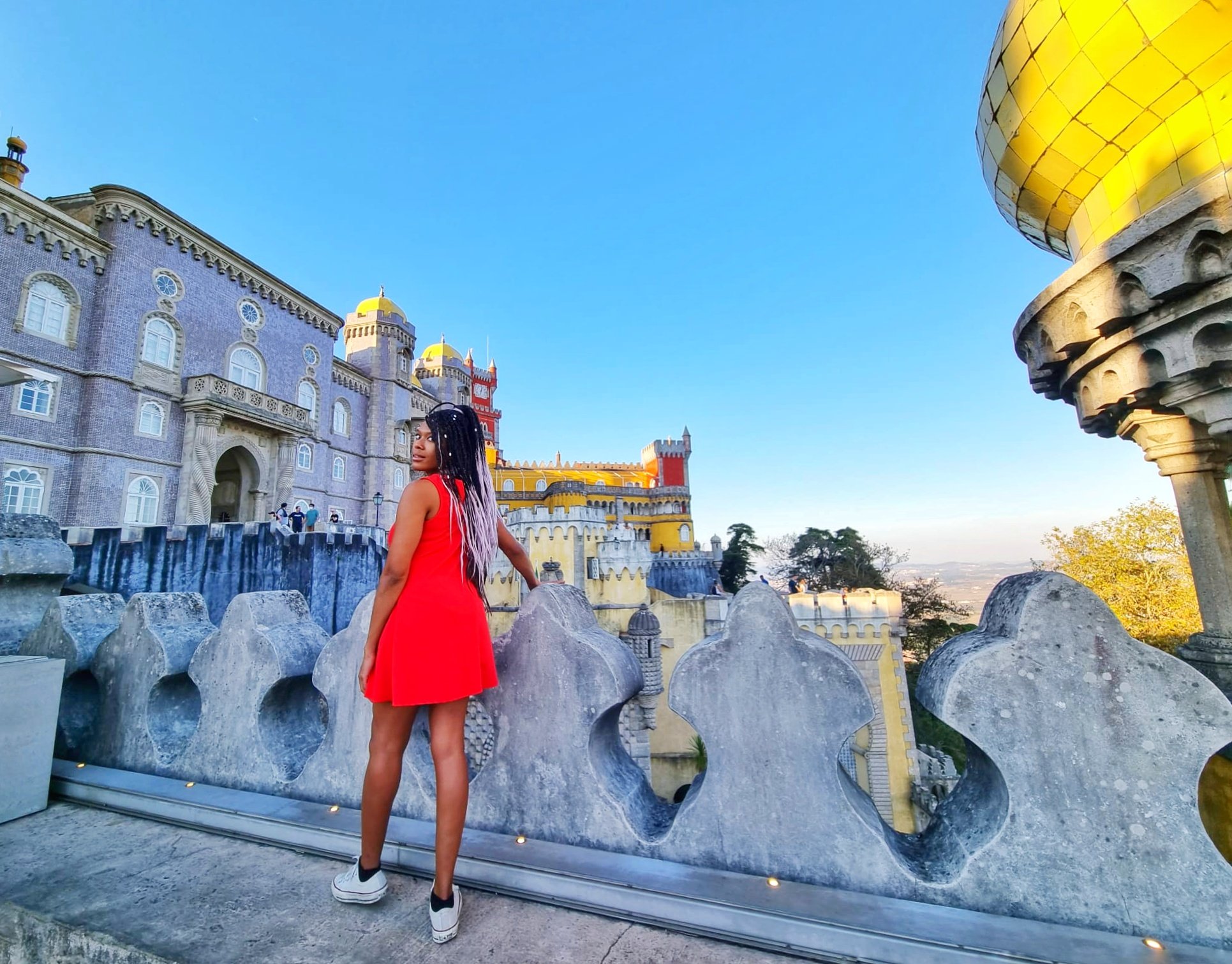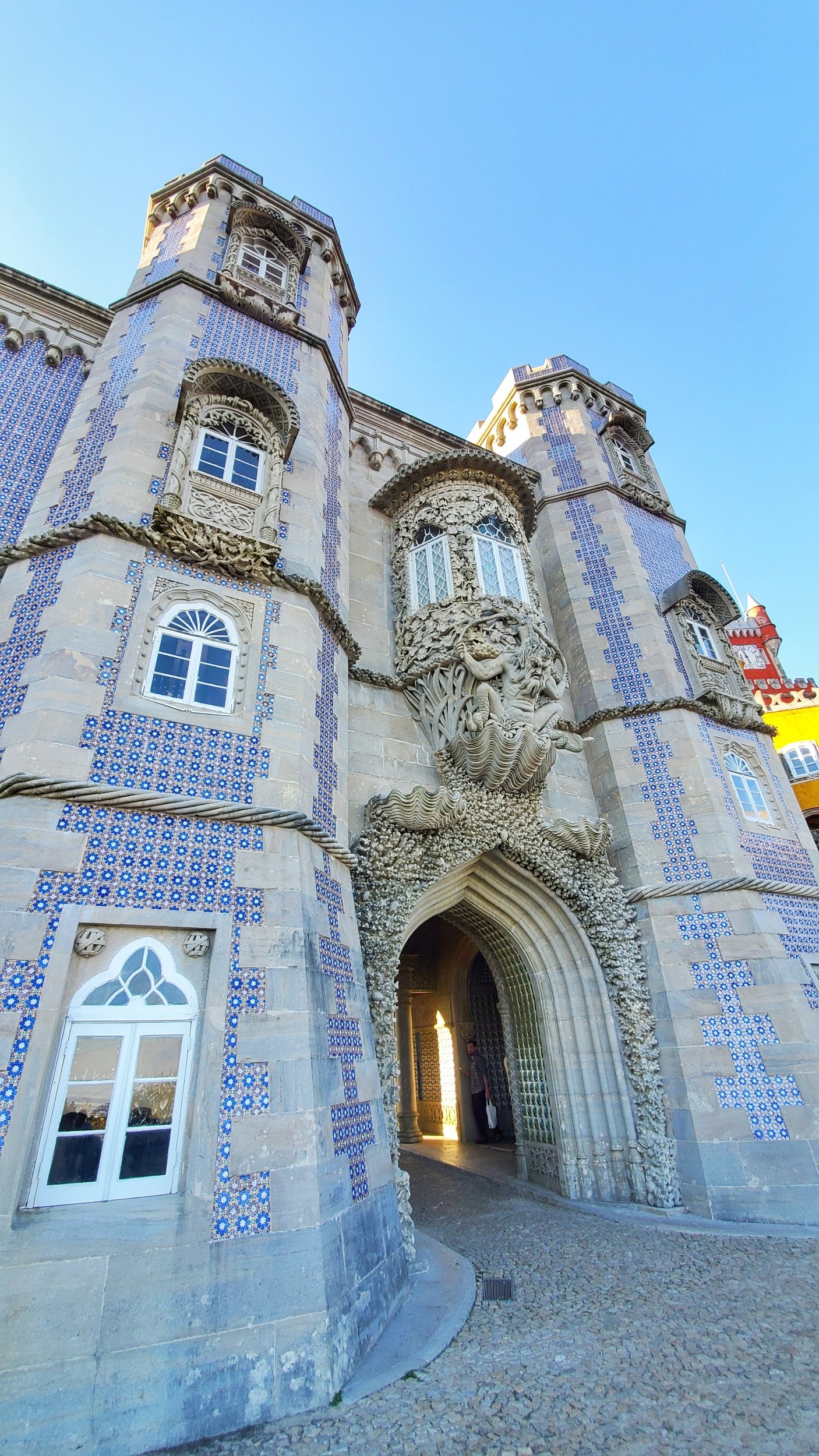The stately Pena Palace is a 19th-century Romanticist castle in Sintra, Portugal’s natural wonderland. Nestled at the top of a peak so high you can spot Lisbon from it on a clear day, this national monument is also a UNESCO World Heritage Site and considered one of the Seven Wonders of Portugal. Pena Palace and the national park that surrounds it should be your first stop in Sintra as undoubtedly the most gorgeous landmarks in the area.
If you want to explore Sintra, Pena Palace is a must-see, especially for any traveler looking for more to do near Lisbon. Located a mere 50 kilometers away in the vast Sintra Hills, getting to Pena Palace is easy via public transportation and the journey takes less than an hour from Lisbon’s city center.
In case you’re dying to visit this palace as much as I was, here’s everything you need to know about visiting Pena Palace and all its splendor. From how to get to Sintra and what to see and do, this guide is exactly what you need to make the most of your time in the area. As the Portuguese say, Vamos!
The Legend
Pena Palace’s story stretches back to the Middle Ages when an apparition of the Virgin Mary appeared in the area, spurring the creation of Our Lady of Pena Chapel. The church became an influential pilgrimage site, even garnering a visit from King John II of Portugal and his wife, Queen Leonor, in 1493. That king’s cousin and successor, King Manuel I, would be so moved by his own trek to Sintra that he would commission a monastery under the Order of Saint Jerome to accompany the original chapel. Over several hundred years, Pena would remain a tranquil sanctuary, popular with nobles seeking refuge for meditation. However, the monastery was heavily damaged by lightning in the 18th century and eventually left in ruins after the Great Lisbon Earthquake of 1755.
Only the chapel survived until 1838 when King Ferdinand II of Portugal acquired the surrounding land to transform them into a summer residence for the Portuguese royal family. The project was overseen by Wilhelm Ludwig von Eschwege, a German engineer and architect, and designed with Medieval and Islamic influences at the behest of the king and his first wife, Queen Maria II.
The royal castle was completed in 1854 after twelve years of construction, incorporating a palace awash in bright colors and enclosed by the idyllic beauty of a forested landscape. After King Ferdinand II died in 1885, possession of the palace fell into his second wife’s hands until the property was again sold to King Luis, King Ferdinand, and Queen Maria II’s second son (meaning the new King of Portugal had to repurchase his family home from his step-mother).
In 1889, the palace and its estate were bought by the Portuguese government and declared a national monument in 1910. The interior was thus renovated and transformed into a museum, rendering it as breathtakingly stunning as the outward façade. Together, the combination helps attract millions of tourists to Sintra every year, particularly after Pena Palace was classified as a UNESCO World Heritage in 1995.
Now you can marvel at the castle’s vividly-hued terraces and mystical statues, or the park’s lush greenery and captivating monuments. Just make sure to get your tickets in advance as space sells out fast at this Portuguese royal paradise.
How to Get to Pena Palace
Sintra is a large region to the northwest of Lisbon and was a popular destination with Portuguese nobility wishing to escape to their countryside residences. Castles and palaces abound in the area, scattered among the imposing Sintra Hills, with Pena Palace only being one of them and each worth its unique day trip.
Thankfully, there are a few ways to get to Sintra that won’t break the bank and take less time than streaming an episode of your favorite Netflix TV series. However, the fastest, most convenient, and most affordable way to arrive at Pena Palace is by utilizing a combination of public transportation so that’s what I’ll cover in this article.
STEP 1: TAKE THE TRAIN
There’s a direct train that connects Lisbon to Sintra’s central hub so head to Rossio Train Station, located downtown just off of the famed Plaza Rossio (AKA King Pedro IV Square). Find one of the many green kiosk machines lined against the interior walls to buy your ticket, payable by debit/credit card or in cash.
You have a few fare options, from one-way trips to round-trips, but I suggested purchasing the day-pass. It’s only slightly more expensive and is valid throughout Sintra for 24 hours, meaning you can go further for less in the end.
Once you’ve chosen your train ticket, swipe the card to make it past the turnstiles onto the train platform; there’s only one with multiple pathways to different train lines. Trains only depart about every hour so make sure to plan your route according to daily timetables (we arrived late and got lucky that our train was still there!). The train ride takes about a half-hour and you should get off at Sintra Estação, right in the heart of Sintra.
At the train station, swipe your transport card again to exit and then head to your right to catch your ride to Pena Palace. Again, you have plenty of options, from hiring a private tuk-tuk (a motor-propelled carriage) to catching the local bus to calling an Uber.
STEP 2A: TAKE THE BUS
If you bought the day-pass as I recommended, you can also use the same ticket to take the local bus straight up to Pena Palace. When you exit the train station, to the right you’ll find the bus stop for Bus 434 whose main destination is the national park (the stop is right across from the tourism office).
If you don’t mind sacrificing a bit more time for money, this method is the most economic option since you won’t need to spend more on transportation to go and come back. It might also be the best route for solo travelers on a budget without company with whom to split the cab fare. The bus ride takes around 10-15 minutes depending on traffic up the hills but, be warned, they do get packed in tourist high season so plan according.
If you’re not sure where to get off, you’ll know you’re in the right place by the massive crush of people who flood out of the bus near the palace. You can also tell the driver you’d like to go to Palᾴcio da Pena and he should point out your stop.
STEP 2B: TAKE A TAXI
Hailing a taxi outside of the train station can be the quickest way to get to Pena Palace if luck is on your side. While you might see several taxis whizz by, many will probably already be full of other visitors, and it might take a moment to find an available car.
Still, if you play your cards right, you should be able to hop into any taxis that arrive to drop off other tourists for their departure journeys. The taxi ride takes less than 10 minutes and should only cost around 5-10€ (we gave up on waiting and used Uber to go up for 8€). Tell the driver you want to go to Palᾴcio da Pena and he should drop you off just in front by the ticket booth.
STEP 2C: TAKE A TUK-TUK
If you’ve never ridden in a tuk-tuk, it’s an exhilarating experience that offers incredible views while getting you where you want to go fast. It’s also more humanitarian than hiring a horse-drawn carriage up treacherous mountain paths for nearly a fraction of the cost. There are plenty of tuk-tuk drivers available for travelers in high season and the easiest place to flag one down is right outside Sintra’s train station.
Feel free to negotiate a price that seems reasonable to you for the short ride up (around 10 minutes) or hire the tuk-tuk for the day if you don’t mind splurging. We went in October 2021 and we were able to haggle our driver down to 12€ for four people (his original price was 15€) to take us from Pena Palace back to Sintra Station. Every penny ended up being worth it as he took us to some amazing viewpoints and a wild ride through the hills.
STEP 3: BUY YOUR TICKETS
Buying your tickets should actually be your first step unless you don’t mind waiting for upwards of a half-hour in the line for the ticket booth. Buy your tickets online to skip the line and to also receive a discount but make sure to purchase them in advance as they tend to sell out a couple days beforehand. We made the mistake of waiting last minute before deciding to go and had to wait around 20 minutes to get our tickets from the ticket agent.
Tickets to see the interior of the castle and its museum are more expensive than those to simply wander about the park, but you don’t have to buy the former to access the castle’s exterior. If you’re pressed for time or not really into interior design or history, I would say for the cheaper ticket to explore the castle from the outside and then explore the park.
You can also buy a mobile audio guide as an add-on as well as download a digital map of the national park (highly recommended so you don’t get lost since the place is huge). Ticket information as of 2021 is as follows:
Pena Palace: 9:30 AM to 6:30 PM
· Last ticket: 5:30 PM
· Last entrance (to interior and museum): 6 PM
Pena National Park: 9 AM to 7 PM
· Last ticket: 6 PM
· Last entrance: 6 PM
Once you make it past the entrance gate, be prepared for the adventure of a lifetime.
What to See in Pena Palace and Pena National Park
The most popular attraction in the national park is unarguably Pena Palace so hike up the steep slopes of the path ahead of you to make your way there. The walk takes around 10-20 minutes depending on your pace but is entirely uphill so I suggest taking it slow to conserve your energy.
Pena Palace has plenty of battlements, bridges, and towers to explore around its perimeter that you might entirely forget to go inside (we did and nearly missed the last entrance into the museum). A few Insta-worthy points of interest are:
Coat of Arms (above the crossing bridge): the insignia of King Ferdinand II
Triton: an allegorical gateway of the Divine Creation
Belvedere (viewpoint): a pavilion with an adjacent bulbous dome
Anywhere around the palace!
If you’re arriving late in the afternoon, I advise you to check out the castle’s museum first (located inside) and then stroll around its exterior afterward. Some key places to visit in the palace are:
The Queen’s Terrace: the best vantage point in the palace
Chapel: the original chapel from the former monastery
King Carlos’ office: a study decorated with paintings done by King Carlos
Watchtowers: looming juggernauts of various shapes and sizes
Manueline Cloisters: an original part of the monastery with 16th-century tiles
Kitchen: an exhibition of royal cutlery and dishware used for banquets
However, the estate is much bigger than it appears on the map so it would probably be better to arrive early to really reap in all the sights without having to be in a rush (like we were). Regardless, when you’ve had your fill of the palace, you can feel free to mosey around the park at your leisure as you tick monuments off your bucket list, like:
Fountain of the Small Birds: an Islamic-style pavilion with a dome inscribed in Arabic
High Cross: a cross carved in stone at the highest point in the Sintra Hills
Valley of the Lakes: five lakes where all water in the park flow in and home to several duck houses
Temple of the Columns: a temple with an excellent viewpoint built on a former chapel for Saint Anthony
Garden of Queen Dona Amelia: a former vegetable garden and orchard
Garden of Camellias: a collection of camellias cultivated since the 19th century
Dovecote House: a multimedia 3D exhibition of Sintra’s landscape
Saint Catherine’s Heights: Queen Dona Amelia’s favorite lookout complete with a throne carved in rock
Statue of the Warrior: a bronze statue in honor of Ernesto Rusconi, Pena’s imaginary medieval knight
Grotto of the Monks: a solitary refuge and meditation for early Hieronymite monks
Table of the Queen: one of Queen Dona Amelia’s favorite hangout spots
Queen’s Fern Valley: a collection of ferns planted a valley with unique climate conditions
Countess’ Fernery: the first collection of tree ferns in Pena, initiated by King Fernando II
Chalet of the Countess of Edla: a large home built by King Fernando II for the Countess of Edla, his second wife
Garden of the Countess of Edla: a botanical garden started by the king and his second wife
Chalet Rocks: another great viewpoint in the area
There are so many places to see in the national park that I couldn’t even begin to list them all (such as an on-site farm) so take advantage of this map to figure out what sights you’d prefer to check out:
Just make sure to make it out of the park before it officially closes you might be stuck inside for the night (true story as it almost happened to us!).
FUN FACT: Queen Dona Amelia, the last queen of Portugal, spent her last night in Pena Palace before leaving Portugal in exile, only returning a handful of times. Her son, Manuel II, would later become the last king of Portugal.
Where to Stay in Sintra
Sintra is a sweeping region off of Portugal’s northern Atlantic coast and encompasses multiple charming towns, tucked away in its misty forests. It’s the perfect escape for nature lovers and hikers along with travelers wanting to explore further outside Lisbon.
Still, the best place to stay is undeniably Sintra’s main town, since it has reliable access to public transportation, a tourism office, and excellent proximity to the train station.
The town is also home to several world-class restaurants serving up some of the finest local Portuguese cuisines so foodies would do well to stay in town as well. No matter your budget or style preferences, there’s sure to be the perfect accommodation for you!
Best budget lodgings
The Five House
This charming guesthouse is situated in an 18th-century villa, just minutes away from Sintra Train Station. For travelers on a budget, the guesthouse offers accommodation in dormitories as well as private rooms, each decorated with a unique theme. Sunbathe on the outdoor terrace or lounge in the quaintly-decorated living room for the ultimate relaxing experience.
Most Romantic Bed & Breakfast
Casa Holstein Quinta de Sao Sebastiao Sintra
This grandoise country home is just minutes from the famed Quinta da Regaleira, complete with opulent rooms equipped with bathrobes and slippers. The property also features a seasonal outdoor swimming pool as well as a sweeping garden, the perfect places to spend your evenings unwinding.
Best Suites for Large Groups
Chalet Saudade
Nestled in the center of Sintra yet hidden away from tourists is this 19th-century hotel within walking distance of Sintra Train Station. The hotel’s decoration features elegant frescoes and tasteful accent pieces while suites include those large enough for patrons traveling with company. Try the breakfast at the complimentary coffee house, Café Saudade, just down the street, or take a stroll around the scenic gardens filled with ponds and fountains to make the most of your time.
Ritziest Boutique Hotel
Sintra Marmoris Palace
Housed with a 19th-century manor, this posh hotel is where you should stay if you want to live in the lap of opulence. You can bask in its heated swimming pool, wander through its 14000 square meter garden, or take in its panoramic views of the Moorish Castle or Sintra Cascais Natural Park. Either way, you’re sure to be kicking back in splendor at the end of each day.
Where to Eat in Sintra
Besides its irresistible palaces and engrossing views, Sintra also excels in the gastronomic scene as home to several fine dining establishments. Thanks to its proximity to the coast, fresh fish and other seafood are essentials in local cuisine as well as organic greens that blend exquisitely for a potent combination. Make sure to stop to grab a bite for lunch and/or dinner and you’re sure never to be disappointed.
Metamorphasis
This alluring Portuguese restaurant is located just a stone’s throw away from Sintra Train Station, making it the perfect spot to grab lunch before continuing with your day. For lovers of seafood and even celiacs, the restaurant specializes in local dishes that will leave you craving for more. I highly recommend getting the mouth-watering ##; it’ll be the highlight of your day.
Address: Rua João de Deus, 43
Romaria de Baco
If you prefer to dine like a local, you should look no further than this neighborhood staple, situated close to the Sintra’s National Palace. Sit below its elegant vaulted wood ceiling while trying the delectable calamari or sipping some local wine; the restaurant actually gets its name from Bacchus, the Roman god of wine.
Address: Rua Gil Vicente, 2
Tascantiga
Catering to travelers with dietary restrictions, this family-friendly restaurant serves everything from vegetarian plates to chicken nuggets for picky youngsters. Perched in the building just above the captivating 14th-century Pipa Fountain, the restaurant also features an outdoor terrace when the weather is willing, making it the perfect place for petiscos (Portuguese-style tapas) while in great company.
Address: Escadinhas de Fonte da Pipa, 2
Incomum by Luis Santos
This glamorous establishment is nestled near Sintra Train Station and is the ideal location for travelers craving a touch of the high life. From its high-end decoration to its gourmet cuisine, this restaurant has opulence in spades. Order the orange- and honey-sweetened duck carpaccio to have a meal as tantalizing as the sights.
Address: Rua Doutor Alfredo da Costa, 22
Casa Piriquita
Arguably the most famous café in Sintra, this vibrant pasteleria has been open since 1862 and has certainly earned its esteemed reputation. While there, sample the mouth-watering travesseiros (translation: pillows), a local almond and cream puff pastry that’s the café’s specialty. Why not also order a cup of coffee or tea for the ultimate palette combination?
Address: Rua Padarias, 1/18
More Activities around Sintra
Sintra is brimming with activities, so many in fact that you might not be able to get to all of them on your first trip. Therefore, you’ll do well to choose where to spend your time wisely, whether wandering around medieval castles or hitting the waves at the beach. This list is only a small taste of what else Sintra has to offer its visitors but they should be enough to keep you occupied from dawn until dusk.
Sintra National Palace
This exceptionally well-preserved medieval palace is not be missed while in Sintra for its prestigious history alone. Positioned right next door to the Sintra’s National History of Museum, the regal estate used to house the royal family from the 14th century to the 17th century and is now emblematic of Sintra’s past as the main retreat for Portuguese nobility. Wander around the decadently-decorated parlors, making sure to visit the Swan Room, The Arab Room, the Magpies’ Room, and the Palace Chapel.
Quinta da Regeilera
This exquisite estate is a must-see, featuring romantic, gothic-style architecture reminiscent of bygone fairytales. Constructed at the behest of Antonio Augusto Carvalho Monteiro, the luxurious residence and its vast grounds were built with his fascination with alchemy, the Masons and Knights Templar in mind. Spot the Manueline symbols carved into the palace’s turrets or marvel at the gargoyles adorning the 5-story edifice.
The biggest draws to La Quinta are its network of underground tunnels as well as the famed Initiation Well, a spiral staircase that descends into darkness. Between the various grottos and towers sprinkled across the park, you’ll have more than enough sights to keep you occupied until sundown.
Convento dos Capuchos
Easily reachable via tuk-tuk, this 16th-century monastery was formerly home to Franciscan monks focused on practicing meditation. Their living conditions were so austere that their rooms were tiny cells bored from rock, the same material used to construct their beds, and ate mostly from the vegetable garden. Check out the remnants in Patio do Tanque, the main courtyard, while touring the monastery’s cells, buildings, and chapel which were inhabited until 1834 when Portuguese monasteries were collectively dissolved.
Castle of the Moors
Feasibly offering the best views of the Atlantic Ocean in the Sintra Mountains, these Moorish ruins aren’t located too far from Sintra. Erected in the 9th century by North African Moors, the once majestic palace stood abandoned for years until it was restored by King Ferdinand II in the 19th century. Explore the ancient cistern or the remains of a Romanesque chapel before getting lost in the magnificent view stretching out past the defensive walls.
Monserrate Palace and Park
Hidden among the mountains just a few kilometers away from Sintra’s town center is this glorious 19th-century palace, originally designed for Sir Francis Cook, the once Viscount of Monserrate thanks to King Luis I. Influenced by the Moorish Revival and featuring Indian and gothic elements, the palace is surrounded by lush gardens filled with grottoes, waterfalls, ponds and bamboo forests. This wonderous landscape shouldn’t be missed for nature lovers and architecture fanatics alike.
Praia da Adraga
As equally popular for its sweeping shores as its palaces, Sintra is home to several white-sand beaches so this one should be high on your list if you plan to hit the waves. Although its high cliff walls outlined by sharpened rocks might make it look intimidating, the beach is family-friendly, sporting a lifeguard all summer long along with a restaurant with a car park. The waves can be a little rough for surfing but the coastline is worth visiting for adventurous travelers due to its extensive caves and tunnels which are enchanting to explore.
Final Thoughts
Sintra seems to burst with magic around nearly every corner, from its dreamy forest landscapes to its opulent palaces and estates. Pena Palace holds a special place among them thanks to its significant historical ties to the royal family along with this eye-catching architectural aesthetic.
You won’t regret venturing to this regal residence but while you’re in Sintra, you might as well take advantage of everything else there is to do in the area. For example, don’t skip out on riding the Sintra Tram, an 11.7 kilometer stretch of tracks that extends through the mountains to Praia das Maçãs on the coast.
Also, why not chow down on some local delicacies, each guaranteed to make your mouth water more than the last? For travelers with a sweet tooth, travesseiro or queijada (a miniature cake crafted with milk, eggs, sugar, and cheese) are sure to satisfy your sugar cravings.
Whether you decide to only visit Pena Palace or plan to tick as many places off as possible, make sure to wear comfy shoes and bring plenty of water. The terrain is quite hilly throughout the region so you’ll probably be walking upward for longer than it takes you to come down so come prepared for the hike. Once you get to the top, you’ll realize that all the effort was worth it for the view. Write me when you get there!
May you get lost in the wonder,
M

